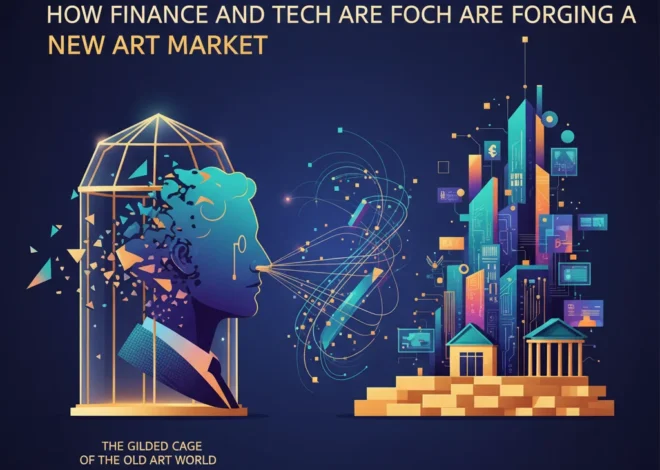
The Great Unlocking: Why Schwab’s Move into Private Markets Is a Game-Changer for Every Investor
The Wall Between Public and Private Investing Is Crumbling
For decades, the world of investing has been sharply divided. On one side, you have the public stock market—the familiar realm of the NYSE and Nasdaq, accessible to anyone with a brokerage account. On the other, the exclusive, velvet-roped world of private equity and venture capital, a domain reserved for institutional players and the ultra-wealthy. This was where the explosive, pre-IPO growth of future giants like Facebook and Google happened, far from the reach of the average investor. But a seismic shift is underway, and a recent development signals that the walls are finally beginning to crumble.
The news that brokerage titan Charles Schwab is in advanced talks to take a stake in Forge Global, a leading marketplace for private company shares, is more than just another corporate deal. As reported by the Financial Times, this strategic move is a powerful indicator of a fundamental transformation in modern finance. It represents the formal recognition that private markets are no longer a niche alternative but a core component of the global economy and a critical frontier for wealth creation. This partnership aims to build a bridge for millions of retail investors to access an asset class that was once the exclusive playground of Silicon Valley insiders and Wall Street behemoths.
This isn’t just about one deal; it’s about the democratization of financial technology, the changing lifecycle of modern companies, and the relentless investor appetite for growth in a complex economic landscape. To understand the full implications, we need to explore why this is happening now and what it means for the future of investing.
The “Stay Private Longer” Phenomenon: Why the Hottest Companies Aren’t on the Stock Market
The traditional corporate playbook used to be simple: start a company, raise a few rounds of venture capital, and then “go public” through an Initial Public Offering (IPO) as soon as possible. The IPO was a celebrated milestone, a way to raise significant capital and provide liquidity for early investors and employees. Today, that playbook has been rewritten.
A flood of private capital from venture funds, sovereign wealth funds, and corporate VCs has created an environment where high-growth companies can raise billions without ever needing to tap the public markets. According to data from PitchBook, the amount of private capital available for investment has soared, allowing companies to reach massive valuations while avoiding the intense regulatory scrutiny, quarterly earnings pressure, and public disclosure requirements that come with an IPO. Giants like Stripe, SpaceX, and Epic Games have become household names and achieved “deca-corn” status (valuations over $10 billion) while remaining privately held.
This trend has created a major problem for public market investors. By the time many of these companies finally go public, a significant portion of their hyper-growth phase is already over. The Schwab-Forge deal is a direct response to this market reality. It acknowledges that if investors want to capture the next wave of innovation, they need a way into the private market ecosystem.
The Apple Tax on Trial: How a UK Ruling Could Redefine Big Tech's Financial Power
Unpacking the Players: A Financial Titan Meets a Fintech Pioneer
To grasp the significance of this partnership, it’s crucial to understand the two key players involved:
- Charles Schwab: A cornerstone of the American financial system, Schwab is a brokerage and banking giant with over $8.5 trillion in client assets. It has built its reputation on making investing more accessible to the general public, from pioneering discount brokerage to offering a vast array of ETFs and mutual funds. Its move into private markets is a logical extension of this mission.
- Forge Global: A leader in the fintech space, Forge operates a secondary market for private securities. It provides a platform for employees and early investors of private, venture-backed companies to sell their shares to accredited investors. In doing so, it creates liquidity in an otherwise illiquid market, solving a major pain point for startup employees who might otherwise have to wait years for an IPO or acquisition to cash in on their equity.
The synergy is clear. Schwab has a massive distribution network of millions of investors hungry for new opportunities. Forge has the technology, regulatory framework, and inventory to provide access to those opportunities. Together, they can create a regulated, streamlined, and more accessible on-ramp to pre-IPO investing.
The New Investment Landscape: Comparing Private and Public Markets
For investors considering this new frontier, it’s vital to understand the fundamental differences between investing in private and public companies. While the potential for high returns is a major draw, the risk profile and investment characteristics are vastly different.
Here is a comparison of the key attributes of each market:
| Feature | Private Market Investing | Public Market Investing |
|---|---|---|
| Accessibility | Historically limited to accredited investors and institutions. Becoming more accessible via platforms like Forge. | Open to all investors through standard brokerage accounts. |
| Liquidity | Low. Selling shares can be difficult and is restricted to secondary market platforms. No guarantee of a buyer. | High. Shares can be bought and sold instantly during market hours on major exchanges. |
| Transparency | Minimal. Financial reporting is not standardized or required to be public. Information is often asymmetric. | High. Companies are required by the SEC to file quarterly and annual reports and disclose material information. |
| Valuation | Determined by private funding rounds (409A valuations) and secondary market transactions. Can be infrequent and subjective. | Determined by real-time supply and demand on the stock market, reflecting collective investor sentiment. |
| Growth Potential | Potentially very high, as investments are made during the company’s early, hyper-growth phase. | Varies, but much of the exponential growth may have already occurred before the IPO. |
| Risk Profile | Very high, including the risk of total loss if the company fails. High volatility and uncertainty. | High, but generally lower than private markets. Diversification is easier, and there’s less risk of a 100% loss for established firms. |
Broader Implications for the Economy and Financial Technology
The Schwab-Forge deal is a microcosm of larger shifts in economics and fintech. The rise of secondary markets is a direct challenge to the traditional dominance of investment banking in the IPO process. For decades, firms like Goldman Sachs and Morgan Stanley were the primary gatekeepers, controlling which companies went public and when. Fintech platforms are disintermediating this process, creating more efficient and continuous pathways to liquidity.
This trend could have profound effects on capital formation and the broader economy. By providing earlier liquidity, these platforms incentivize top talent to join startups, as they no longer have to wait a decade for a “liquidity event.” It also allows for more efficient price discovery before an IPO, potentially reducing the infamous “IPO pop” where shares soar on the first day of trading, suggesting the company was undervalued by its bankers.
Furthermore, the technology underpinning these platforms is a key part of the story. The complex trading, compliance, and cap table management required for private share transactions rely on sophisticated financial technology. This includes everything from digital verification of accredited investor status to secure platforms for transaction settlement. Some experts believe the next evolution will involve blockchain technology to create tokenized representations of private shares, enabling fractional ownership and near-instant settlement. (source)
A Tale of Two Titans: Why Wall Street Cheered Google's AI Strategy and Jeered Meta's
A Word of Caution: Navigating the High-Stakes World of Private Investing
While the democratization of private market access is an exciting development, it comes with significant caveats. This is not the same as buying a blue-chip stock or an S&P 500 ETF. The risks are substantially higher, and investors must proceed with caution.
- Illiquidity Risk: Even with secondary markets, there is no guarantee you will be able to sell your shares when you want or at the price you want. You should be prepared to hold these investments for many years.
- Information Asymmetry: Private companies are not subject to the same rigorous disclosure rules as public ones. You will be making investment decisions with far less information, putting you at a disadvantage.
- Valuation Risk: Private valuations can be volatile and are often based on the sentiment of a small number of large investors. A “down round,” where a company raises money at a lower valuation than before, can significantly wipe out the value of your stake.
For these reasons, investing in private companies should only be considered by sophisticated investors who have a high-risk tolerance and have already built a well-diversified portfolio of traditional assets. It should represent a small, speculative portion of one’s overall investment strategy.
The Price of Peace: Why Economic Incentives Alone Can't Solve the Gaza Crisis
Conclusion: A New Chapter in Wealth Creation
The potential partnership between Charles Schwab and Forge Global is a landmark event. It signifies the maturation of the private markets and their integration into the mainstream financial ecosystem. This is more than a fintech story; it’s a fundamental shift in how capital is allocated, how companies grow, and how wealth is created in the modern economy.
For investors, it opens a door that was once firmly locked. But walking through that door requires a clear understanding of the new landscape, a healthy respect for the risks involved, and a long-term perspective. The worlds of public and private investing are converging, and for those who are prepared, this new era of finance offers unprecedented opportunity.


